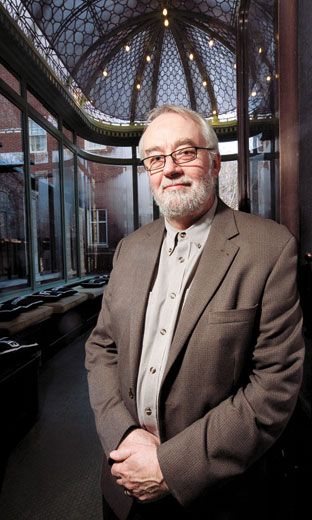Q and A with Bill Moggridge
The director of the Cooper-Hewitt National Design Museum discusses the future of computing and design
/https://tf-cmsv2-smithsonianmag-media.s3.amazonaws.com/filer/QA-Bill-Moggridge-631.jpg)
This past November, Bill Moggridge, director of the Cooper-Hewitt, National Design Museum, received the 2010 Prince Philip Designers Prize—Britain’s most prestigious design award—for his lifetime contribution to the field. He spoke with the magazine’s Megan Gambino.
What is the biggest misconception about design?
Many people think of “design heroes”—gifted people who strive only to create a beautiful project. Design is so much broader than that. It’s about solving problems.
In 1981, you designed the first laptop computer, the GRiD Compass, years before companies even began marketing desktop computers. What prompted you to do that?
The impetus came from John Ellenby, an entrepreneurial engineer who had been working at Xerox PARC [Palo Alto Research Center] and founded GRiD Systems Corporation. He was talking to someone in the White House—someone with a top-secret job—whose computer was larger than his desk. This person said that what he really needed in order to do his job effectively was the same computing power encased in something that would fit in half his briefcase. And that became our guiding principle.
You specialize in “interaction design.”
It’s the equivalent of physical design, but applied to the digital and virtual world. Back in 1981, I brought my laptop home, the first prototype I had the chance to use myself. For the first five minutes I was still proud of all the work I had been doing for a year and a half, thinking how valuable it was that I had created the physical form, with a nice looking display that folded over the keyboard. But soon I felt myself being sucked down into the virtual realm, concerned only with how I interacted with the software, and forgetting the existence of the physical object. That’s when I realized the significance of human-computer interaction.
Will the laptop survive in the 21st century?
I think it will last forever. It’s a form that is very practical: a large display that’s the right distance from your eyes and an input setup—a keyboard plus a track pad or whatever it might be—right in front of you. And, it is very portable. We will continue to see new devices like the iPad, and there has been a lot of work on versions of computers with handwriting and voice inputs, so that all you need is the display. Some people will use that instead of their laptop. But I think these trends will exist in parallel with one another. I can’t see the laptop ever being completely replaced.
What object has the best design?
If I think of very simple designs, I love something as uncomplicated as a paper clip, because it is such a neat way of solving a problem with very little material. If I think about something more sensuous, I’ve always been interested in the perfect spoon. It is delectable in a multisensory way: the appearance, the balance and feeling as you pick it up off the table, then the sensation as it touches your lips and you taste the contents.
I have heard that you want every child to have some exposure to design by age 12. How come?
The ambition is to allow every kid to have some experience of design before they are 12 and the opportunity to study it in high school if they wish. That does happen in some other countries, but, at the moment, design is only included in specialist schools in the U.S. Design is an excellent bridge between the sciences and the arts, with designers developing both talents. They want to be problem solvers but they want to do it in some way that includes aesthetics, and the subjective values inherent in the arts. Design is a very powerful tool for young people to understand that they can learn by doing as well as learning by listening and trying to remember.
You once said in an interview that you learned the hard way to embrace failure as a faster path toward success.
The willingness to embrace failure should be part of the design process, even if some design teams find that difficult to get used to. A lot of people will say, “Let’s wait until we get the prototype perfect before we actually show it to anybody.” The best way to achieve a result is to take the biggest risk as early as you possibly can, make a mistake and then go on and do it a second or a third time. You show it to people and try it out, let it fail and advance much more quickly.
/https://tf-cmsv2-smithsonianmag-media.s3.amazonaws.com/accounts/headshot/megan.png)

/https://tf-cmsv2-smithsonianmag-media.s3.amazonaws.com/accounts/headshot/megan.png)